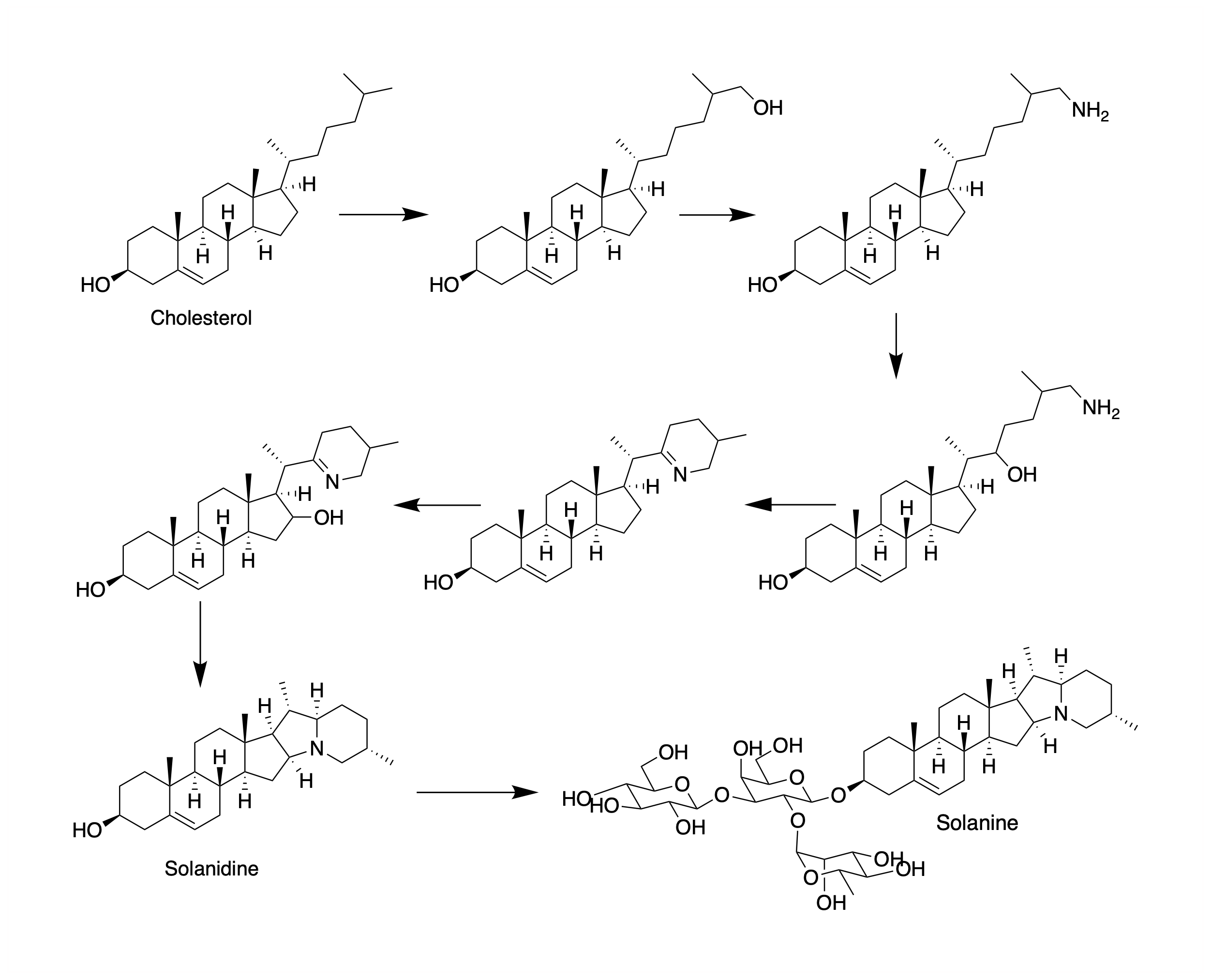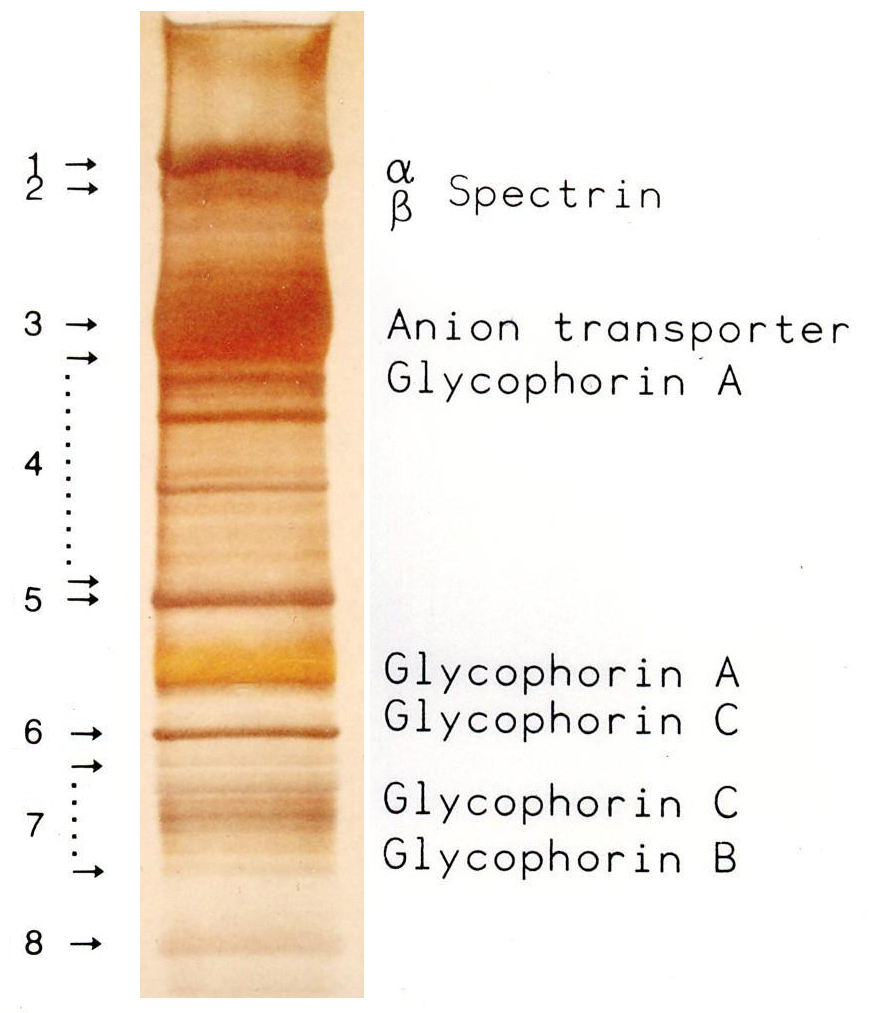|
Chaconine
α-Chaconine is a steroidal glycoalkaloid that occurs in plants of the family Solanaceae. It is a natural toxicant produced in green potatoes and gives the potato a bitter taste. Tubers produce this glycoalkaloid in response to stress, providing the plant with insecticidal and fungicidal properties. It belongs to the chemical family of saponins. Since it causes physiological effects on individual organism, chaconine is considered to be a defensive allelochemical. Solanine, a related substance also found in potatoes, has similar properties. Symptoms and treatment Symptoms resemble those seen following solanine ingestion including abdominal pain, diarrhea, and headache. There is currently no antidote for detoxification but if it is just after consumption, taking laxatives or gastric lavage could be effective. The symptoms could last several days. Toxicity The presence of more than 20 mg/100 g tuber glycoalkaloids is toxic for humans. There have been instances of ... [...More Info...] [...Related Items...] OR: [Wikipedia] [Google] [Baidu] |
Solanine
Solanine is a glycoalkaloid poison found in species of the Solanaceae, nightshade family within the genus ''Solanum'', such as the potato (''Solanum tuberosum''). It can occur naturally in any part of the plant, including the Leaf, leaves, fruit, and tubers. Solanine has Pesticide, pesticidal properties, and it is one of the plant's Plant defense against herbivory, natural defenses. Solanine was first isolated in 1820 from the Berry (botany), berries of the European black nightshade (''Solanum nigrum''), after which it was named. It belongs to the chemical family of saponins. Solanine poisoning Symptoms Solanine poisoning is primarily displayed by gastrointestinal and neurological disorders. Symptoms include nausea, diarrhea, vomiting, stomach cramps, burning of the throat, cardiac dysrhythmia, nightmares, headache, dizziness, itching, eczema, thyroid problems, and inflammation and pain in the joints. In more severe cases, hallucinations, loss of sensation, paralysis, fever ... [...More Info...] [...Related Items...] OR: [Wikipedia] [Google] [Baidu] |
Solanaceae
Solanaceae (), commonly known as the nightshades, is a family of flowering plants in the order Solanales. It contains approximately 2,700 species, several of which are used as agricultural crops, medicinal plants, and ornamental plants. Many members of the family have high alkaloid contents, making some highly toxic, but many—such as tomatoes, potatoes, eggplants, and peppers—are commonly used in food. Originating in South America, Solanaceae now inhabits every continent on Earth except Antarctica. After the K—Pg extinction event they rapidly diversified and have adapted to live in deserts, tundras, rainforests, plains, and highlands, and taken on wide range of forms including trees, vines, shrubs, and epiphytes. Nearly 80% of all nightshades are included in the subfamily Solanoideae, most of which are members of the type genus ''Solanum''. Most taxonomists recognize six other subfamilies: Cestroideae, Goetzeoideae, Nicotianoideae, Petunioideae, Schizanthoideae, an ... [...More Info...] [...Related Items...] OR: [Wikipedia] [Google] [Baidu] |
Steroidal Alkaloid
Steroidal alkaloids have the basic steroidal skeleton with nitrogen-based functional groups attached to the skeleton. More specifically, they are distinguished by their tetracyclic cyclopentanoperhydrophenanthrene skeleton that marks their close relationship with sterols. They fall in two major categories: Solanum alkaloids and Veratrum alkaloids. A Steroidal alkaloid has also been found in ''Chonemorpha fragrans'' (Frangipani vine), 'chonemorphine' was used to treat intestinal infections in Wistar rats. (Chatterjee DK et al (1987) Parasitol Res 74, 1, 30-33). Examples Apocynaceae steroid alkaloids The family of apocynaceae alkaloids can be categorized based on their backbone structure, which may include the 5α-pregnane, Δ5-pregnane, or conanine backbone. Typically, these alkaloids feature an amino group or an oxygen compound at the 3rd carbon atom. An illustrative example is latifolinin, which is derived from the conanine backbone. This distinctive structure is charact ... [...More Info...] [...Related Items...] OR: [Wikipedia] [Google] [Baidu] |
Potatoes
The potato () is a starchy tuberous vegetable native to the Americas that is consumed as a staple food in many parts of the world. Potatoes are underground stem tubers of the plant ''Solanum tuberosum'', a perennial in the nightshade family Solanaceae. Wild potato species can be found from the southern United States to southern Chile. Genetic studies show that the cultivated potato has a single origin, in the area of present-day southern Peru and extreme northwestern Bolivia. Potatoes were domesticated there about 7,000–10,000 years ago from a species in the '' S. brevicaule'' complex. Many varieties of the potato are cultivated in the Andes region of South America, where the species is indigenous. The Spanish introduced potatoes to Europe in the second half of the 16th century from the Americas. They are a staple food in many parts of the world and an integral part of much of the world's food supply. Following millennia of selective breeding, there are now over 5,00 ... [...More Info...] [...Related Items...] OR: [Wikipedia] [Google] [Baidu] |
Steroidal Alkaloids
Steroidal alkaloids have the basic steroidal skeleton with nitrogen-based functional groups attached to the skeleton. More specifically, they are distinguished by their tetracyclic cyclopentanoperhydrophenanthrene skeleton that marks their close relationship with sterols. They fall in two major categories: Solanum alkaloids and Veratrum alkaloids. A Steroidal alkaloid has also been found in ''Chonemorpha fragrans'' (Frangipani vine), 'chonemorphine' was used to treat intestinal infections in Wistar rats. (Chatterjee DK et al (1987) Parasitol Res 74, 1, 30-33). Examples Apocynaceae steroid alkaloids The family of apocynaceae alkaloids can be categorized based on their backbone structure, which may include the 5α-pregnane, Δ5-pregnane, or conanine backbone. Typically, these alkaloids feature an amino group or an oxygen compound at the 3rd carbon atom. An illustrative example is latifolinin, which is derived from the conanine backbone. This distinctive structure is characte ... [...More Info...] [...Related Items...] OR: [Wikipedia] [Google] [Baidu] |
Solanidine
Solanidine is a poisonous steroidal alkaloid chemical Chemical compound, compound that occurs in plants of the family Solanaceae, such as potato and ''Solanum americanum''. The sugar portion of glycoalkaloids hydrolyses in the body, leaving the solanidine portion. Occurrence Solanidine is the hydrolyzed form of several naturally occurring compounds all found in the Solanaceae family, such as glycoalkaloids, α-solanine and α-chaconine.Kuiper-Goodman, T., Nawrot, P.S.Solanine and Chaconine IPCS Inchem Solanidine is not commonly found in nature, but precursors to it are. Glycoalkaloids are one of the toxins present in Solanum dulcamara and can be found in other Solanum plants as well such as potatoes, tomatoes and eggplant. Solanine is also found in all parts of the Solanum family species and is considered part of the plant's natural defenses. Chaconine is found in specifically green tubers and gives them their bitter taste. Solanidine is found naturally occurring in green potatoe ... [...More Info...] [...Related Items...] OR: [Wikipedia] [Google] [Baidu] |
Institute Of Physical And Chemical Research
is a national scientific research institute in Japan. Founded in 1917, it now has about 3,000 scientists on seven campuses across Japan, including the main site at Wakō, Saitama Prefecture, on the outskirts of Tokyo. Riken is a Designated National Research and Development Institute, and was formerly an Independent Administrative Institution. Riken conducts research in various fields of science, including physics, chemistry, biology, genomics, medical science, engineering, high-performance computing and computational science, and ranging from basic research to practical applications with 485 partners worldwide. It is almost entirely funded by the Japanese government, with an annual budget of ¥100 billion (US$750 million) in FY2023. Name "Riken" is an acronym of the formal name , and its full name in Japanese is and in English is the Institute of Physical and Chemical Research. History In 1913, the well-known scientist Jokichi Takamine first proposed the establishment of ... [...More Info...] [...Related Items...] OR: [Wikipedia] [Google] [Baidu] |
Saponins
Saponins (Latin ''sapon'', 'soap' + ''-in'', 'one of') are bitter-tasting, usually toxic plant-derived secondary metabolites. They are Organic compound, organic chemicals that become foamy when agitated in water and have high Molar mass, molecular weight. They are present in a wide range of plant species throughout the bark, leaves, stems, roots and flowers but particularly in Saponaria, soapwort (genus ''Saponaria''), a flowering plant, the Quillaja saponaria, soapbark tree (''Quillaja saponaria''), Agrostemma githago, common corn-cockle (''Agrostemma githago'' L.), Gypsophila, baby's breath (Gypsophila, ''Gypsophila'' spp.) and soybeans (''Soybean, Glycine max'' L.). They are used in soaps, medicines (e.g. drug adjuvants), fire extinguishers, dietary supplements, steroid synthesis, and in carbonated beverages (for example, being responsible for maintaining the head on root beer). Saponins are both water and fat soluble, which gives them their useful soap properties. Some example ... [...More Info...] [...Related Items...] OR: [Wikipedia] [Google] [Baidu] |
Alkaloid Glycosides
Alkaloids are a broad class of naturally occurring organic compounds that contain at least one nitrogen atom. Some synthetic compounds of similar structure may also be termed alkaloids. Alkaloids are produced by a large variety of organisms including bacteria, fungi, plants, and animals. They can be purified from crude extracts of these organisms by acid-base extraction, or solvent extractions followed by silica-gel column chromatography. Alkaloids have a wide range of pharmacological activities including antimalarial (e.g. quinine), antiasthma (e.g. ephedrine), anticancer (e.g. homoharringtonine), cholinomimetic (e.g. galantamine), vasodilatory (e.g. vincamine), antiarrhythmic (e.g. quinidine), analgesic (e.g. morphine), antibacterial (e.g. chelerythrine), and antihyperglycemic activities (e.g. berberine). Many have found use in traditional or modern medicine, or as starting points for drug discovery. Other alkaloids possess psychotropic (e.g. psilocin) and stimulant acti ... [...More Info...] [...Related Items...] OR: [Wikipedia] [Google] [Baidu] |
Solamargine
Solamargine is a cytotoxic chemical compound that occurs in plants of the family Solanaceae, such as potatoes, tomatoes, and eggplants. It has been also isolated from ''Solanum nigrum'' fungal endophyte ''Aspergillus flavus''. It is a glycoalkaloid derived from the steroidal alkaloid solasodine Solasodine is a poisonous alkaloid chemical compound that occurs in plants of the family Solanaceae such as potatoes and tomatoes. Solasonine and solamargine are glycoalkaloid derivatives of solasodine. Solasodine is teratogenic to hamster fe .... Solamargine was one component of the unsuccessful experimental cancer drug candidate Coramsine. See also * '' Solanum americanum'' References External links *{{Commonscatinline Steroidal alkaloids Alkaloid glycosides Plant toxins Steroidal alkaloids found in Solanaceae ... [...More Info...] [...Related Items...] OR: [Wikipedia] [Google] [Baidu] |
Genome Editing
Genome editing, or genome engineering, or gene editing, is a type of genetic engineering in which DNA is inserted, deleted, modified or replaced in the genome of a living organism. Unlike early genetic engineering techniques that randomly insert genetic material into a host genome, genome editing targets the insertions to site-specific locations. The basic mechanism involved in genetic manipulations through programmable nucleases is the recognition of target genomic loci and binding of effector DNA-binding domain (DBD), double-strand breaks (DSBs) in target DNA by the restriction endonucleases (FokI and CRISPR associated protein, Cas), and the repair of DSBs through homology-directed recombination (HDR) or non-homologous end joining (NHEJ). History Genome editing was pioneered in the 1990s, before the advent of the common current nuclease-based gene-editing platforms, but its use was limited by low efficiencies of editing. Genome editing with engineered nucleases, i.e. all three m ... [...More Info...] [...Related Items...] OR: [Wikipedia] [Google] [Baidu] |
Acrylamide
Acrylamide (or acrylic amide) is an organic compound with the chemical formula CH2=CHC(O)NH2. It is a white odorless solid, soluble in water and several organic solvents. From the chemistry perspective, acrylamide is a vinyl-substituted primary amide (CONH2). It is produced industrially mainly as a precursor to polyacrylamides, which find many uses as water-soluble thickeners and flocculation agents. Acrylamide forms in burnt areas of food, particularly starchy foods like potatoes, when cooked with high heat, above . Despite health scares following this discovery in 2002, and its classification as a probable carcinogen, acrylamide from diet is thought unlikely to cause cancer in humans; Cancer Research UK categorized the idea that eating burnt food causes cancer as a "myth". Production Acrylamide can be prepared by the hydration of acrylonitrile, which is catalyzed enzymatically: :CH2=CHCN + H2O → CH2=CHC(O)NH2 This reaction also is catalyzed by sulfuric acid as wel ... [...More Info...] [...Related Items...] OR: [Wikipedia] [Google] [Baidu] |





